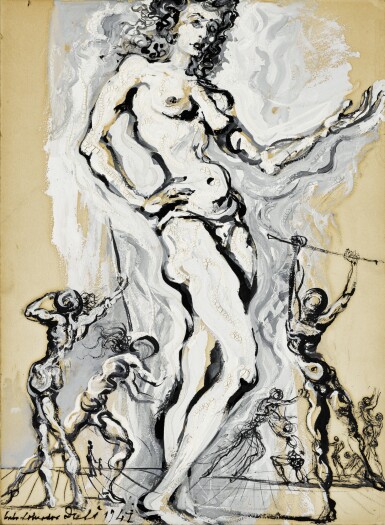
SALVADOR DALÍ | NU FÉMININ SPECTRAL
Lot Closed
February 12, 03:10 PM GMT
Estimate
60,000 - 80,000 GBP
Lot Details
Description
Property from a Private Collection, Chicago
SALVADOR DALÍ
1904 - 1989
NU FÉMININ SPECTRAL
signed Salvador Dalí, inscribed Gala and dated 1947 (lower left)
gouache, ink wash and pen and ink on board
Unframed 38.1 by 27.9 cm., 15 by 11 in.
Framed 50 by 39.5 cm
Executed in 1947.
Please see Shipping Calculator Link: Click Here
Charles H. Swift & Claire Dux Swift, Chicago (acquired directly from the artist)
Dieter Dux & Marilyn Dux, Cleveland (a gift from the above on 3rd September 1948)
Thence by descent to the present owner
Nicolas and Olivier Descharnes have kindly confirmed the authenticity of this work.
Nu Féminin Spectral, executed in 1947, is a unique painterly vision of skilled technical virtuosity and a stunning example of Salvador Dalí giving visual expression to the intangible images of the subconscious. The present work depicts a monumental nude woman, towering above a throng of action, violence and suspense. Assuming an elegant stance and an unphased expression, the woman is confusingly subject to torture and unease. This thought-provoking artwork evokes all the complexities that Dalí associated with erotic attraction; the contrast between pleasure and suffering and, ultimately, life and death.
Dalí executed Nu Féminin Spectral at the height of his New York period, having fled Paris with his wife Gala at the outbreak of World War II. The work is inscribed with both Dalí and Gala’s names, which the artist began in the 1930s, signifying how his life and persona became so entwined with that of his partner that he no longer regarded his artistic creations as independent from her influence: ‘it is mostly with your blood, Gala, that I paint my pictures’ (S. Dalí, The Secret Life of Salvador Dalí, New York, 1942, p. 301). An incredibly complex relationship formed between the two; they met in 1929 and it was love at first sight but according to most accounts, Gala had a strong libido and had numerous extramarital affairs, which Dalí encouraged since he was a practitioner of candaulism.
While Nu Féminin Spectral imbues the complexities of love, lust and jealousy, it simultaneously evokes an image of divinity and reverence. Despite the surrounding chaos that befalls the woman, her God-like presence is synonymous with the mystical Gradiva or the Goddess of Venus, two characters which continued to appear throughout Dalí’s œuvre. In the 1903 novel by Wilhelm Jenson, the fictitious woman Gradiva stands as a personification of unrequited love. Concurrently, the calm pose of the woman reflects images of Venus, the classical symbol of love, beauty and fertility. Established as one of Dalí’s favourite subjects, Robert Descharnes writes: ‘It was Venus he took apart and re-assembled in his carefully observed early paintings of woman. He painted woman in the style of Seurat, Picasso, or Matisse; he painted them in his cubist phase, in classical mood, in pre-Surrealist manner, and on, till the time came when his Venus invariably bore the features of Gala’ (Robert Descharnes & Gilles Neret, Salavdor Dalí 1904-1989, The Paintings, Volume I, 1904-1946, Cologne, 1994, pp. 69-70).
During this period, Dalí was championing his paranoiac-critical method – his term for the controlled use of freely associated imagery and subjects derived from self-induced hallucinations. These fantastical apparitions often combined with myriad references to moments of the past, such as the martyrdom of Saint Sebastian, which is strongly reflected in the present work. The two figures flanking the central figure are mirroring Sebastian’s attackers; an arrow is shot from the figure on the far left and the right-hand figure lunges towards the woman brandishing a stick. The artist revered the Saint due to his remarkable emotional control which ‘Gala’ is certainly emulating.
Encapsulating the fascination of artists with their muses as objects of desire, Nu Féminin Spectral is a continuation of the romantic tradition of ideal beauty as guiding the choices and artistic manifestations of the male artist. Dali’s desire to create a Surrealist space is evident in the strange perspectival illusion of the receding scene, through which the viewer can glimpse an intimate moment between a mother and child. An archetypal Dalí drawing in its physiological intensity and prodigious technicality, Nu Féminin Spectral effortlessly combines dynamic chaos with a pervading stillness, enhanced by the fluidity of the sinuous black lines, contrasting with the effective use of white. Dalí preferred passion over restraint, desire to its sublimation, the erotic power of the subconscious, to the cool equivocation of reason. This intimate yet dominating work encompasses the polarisation of the themes of power, beauty, sexuality and fragility that fascinated the Surrealists in their incessant preoccupation with the subject of woman. This tantalising work was directly acquired by friends of Dalí - Charles and Claire Dux Swift - the latter being a famous operatic and concert soprano, who Dalí painted in 1942.
